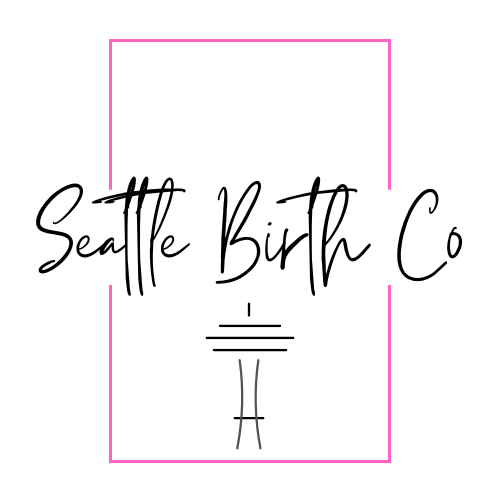Birth Plan: What to include & Template to use
When you imagine your birth, what matters most to you? The atmosphere? The level of medical involvement? Who will be by your side? A birth plan helps you clarify those preferences and communicate them clearly to your care team — whether you’re planning a hospital birth, a home birth, or a midwifery-led experience.
As a Seattle birth doula, I often describe a birth plan not as a rigid script but as a communication tool. Birth rarely follows a straight line, but when you and your support team understand your values and priorities, it becomes much easier to adapt confidently if things change.
What Is a Birth Plan?
A birth plan is a simple written outline of your wishes for labor, delivery, and immediate postpartum care. It includes your preferences around pain relief, environment, newborn procedures, and who will be present.
Think of it as your roadmap for birth advocacy — a way to ensure that your care providers, doula, and partner are all on the same page about what matters most to you.
Why Create a Birth Plan
Writing a birth plan gives you a chance to explore your options and ask thoughtful questions before labor begins. Many families tell me that this process helped them feel more informed, less anxious, and more empowered.
It’s also a tool for collaboration. By discussing your preferences ahead of time, your provider, birth doula, and partner can anticipate your needs and help you create an environment that feels calm and supportive.
Do I Need a Birth Plan?
You don’t have to create a birth plan, but many families find it incredibly helpful — especially if you have specific preferences or simply want your care team to understand what matters most to you. The process of writing one often brings clarity and comfort as you prepare for labor and birth.
Reviewing your plan with your provider or birth doula ahead of time can help you spot potential surprises and set realistic expectations. You might discover, for instance, that your hospital birth plan needs to align with certain policies about photography or support people, or that your midwifery birth plan allows more flexibility in those areas.
It’s also helpful to stay open-minded. Sometimes things shift in labor, and your care team may suggest adjustments based on what’s safest for you and your baby. The goal isn’t perfection — it’s communication and collaboration. On the day of your birth, your plan serves as a gentle guide for your team and a reminder of your values when you’re focused on the work of bringing your baby into the world.
What to Include in Your Birth Plan
Your birth plan will look slightly different depending on where and how you plan to give birth. Below are a few key areas to consider — all reflected in the Seattle Birth Co birth plan template.
1. Labor Environment
What helps you feel safe and focused? Dim lighting, soft music, and aromatherapy are popular choices. Some families ask to minimize unnecessary interruptions or exams to maintain a calm rhythm in labor.
2. Pain Relief Preferences
Include both your ideal plan and your backup options. For instance, some parents prefer to labor naturally with comfort tools such as a TENS unit, nitrous oxide, movement, or water therapy, while keeping an epidural as an option later.
3. Delivery Preferences
Would you like to “labor down” before pushing, use a warm compress, or avoid perineal stretching? Would you like delayed cord clamping or for your partner to cut the cord? Detailing these ahead of time ensures your team supports your vision.
4. Baby Care
Include your preferences for newborn procedures — like Vitamin K, eye ointment, or Hepatitis B — and note whether you’d like skin-to-skin contact immediately, breastfeeding assistance, or donor milk if supplementation is needed.
5. In Case of a Cesarean Birth
Even planned cesareans can reflect your values. You might request music in the OR, a clear drape to witness birth, or skin-to-skin contact as soon as possible afterward.
Hospital, Birth Center, and Home Birth Plans
Hospital Birth Plan: Hospitals vary widely in policies, so clear communication is key. Discuss IV access, monitoring preferences, and postpartum routines in advance with your care team.
Birthing Center Birth Plan: Midwives generally prioritize client-led care. Your plan might focus on environment, mobility, and newborn bonding.
Home Birth Plan: A home birth plan often emphasizes freedom of movement, birth positions, and creating a peaceful space with your doula near you for hands-on support.
Your plan can evolve as your pregnancy progresses — it’s a living document, not a fixed list.
Tips for Writing a Birth Plan That Works
Keep it simple and focused. Aim for one page with clear, kind language.
Share it early. Review it with your provider and doula well before labor begins.
Stay flexible. A birth plan works best when it guides your care, not dictates it.
Your birth doula can help you refine your plan, making sure it reflects both your preferences and your chosen birth setting — whether hospital, midwifery care, or home.
Use Our Free, Printable Birth Plan Template
To make things easier, we’ve created a free, printable birth plan template you can customize to your needs — whether you’re planning a hospital birth, home birth, or midwifery care. It includes space for your preferences around environment, pain relief, newborn care, and postpartum choices.
Fill it out, review it with your provider or doula near you, and keep a copy in your hospital or birth bag. Sharing it early ensures that everyone — from your nurse to your birth support team — knows how to honor your wishes when the big day arrives.
Final Thoughts
A birth plan is ultimately about birth advocacy — helping you express what matters most while remaining open to the flow of birth. It gives your birth support team clear guidance while keeping your voice at the center of decision-making.
Whether you’re preparing for a hospital birth in Bellevue, a midwife-led birth in Kirkland, or a home birth in Snohomish County, a well-thought-out plan ensures everyone involved understands how to best support you through one of life’s most transformative moments.

